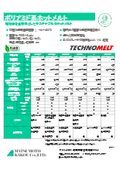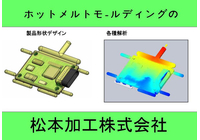Hot melt molding for waterproofing, dustproofing, and cost reduction of circuit boards.
"Complete sealing of electrical components in just a few dozen seconds. Ideal for waterproofing, dustproofing, and insulation!" Hot melt molding is gaining attention for the waterproof sealing of electrical components.
"Complete sealing of electronic components in just a few dozen seconds. Ideal for waterproofing, dustproofing, and insulation!" Hot melt molding, which is gaining attention for waterproof sealing of electronic components, utilizes thermoplastic adhesives in low-pressure insert molding to achieve environmental protection such as waterproofing and dustproofing for electronic components like mounted circuit boards. Compared to traditional two-component potting and conformal coating, sealing is completed in an extremely short time, leading to an expansion in its adoption as a sealing technology. We propose a sustainable hot melt made primarily from natural fatty acids. At the Matsumoto Processing Lab, nine hot melt molding machines are installed, and you can observe the actual process of hot melt sealing electronic components. Customers interested in visiting are encouraged to inquire.
basic information
Forming and sealing electronic components with a one-component thermoplastic adhesive that is free of unnecessary agents. By sealing and forming with the adhesive, it firmly adheres to the substrate (such as printed circuit boards) and prevents water intrusion. The material has a proven track record of use in environments ranging from -40°C to 150°C. Matsumoto Processing is capable of forming and sealing using hot melts based on polyamide, polyolefin, polyurethane, and polyester. Matsumoto Processing will propose the optimal hot melt, perform shape modeling, analysis verification, and prototype creation based on the characteristics required by the customer's product. For customers wishing to implement the process in-house, we provide comprehensive support including the production of forming machines, molds, development of forming conditions, startup assistance, and supply of hot melts. For customers who wish to outsource hot melt forming, we offer hot melt forming contract services at Matsumoto Processing's factory.
Price range
Delivery Time
Model number/Brand name
Low Pressure Molding, Hot Melt Molding, Waterproof and Dustproof, Encapsulation Molding
Applications/Examples of results
1. Protection of various sensors and control circuits for automobiles Domestic and international automobile manufacturers Domestic automotive parts manufacturers 2. Battery-related Domestic battery manufacturers 3. Other electronic devices Domestic home appliance manufacturers Domestic sensor manufacturers Domestic harness assembly manufacturers
Detailed information
-

Examples of waterproof sealing for agricultural machinery substrates. The left photo shows before sealing, and the right photo shows after sealing (the black area is the hot melt molded part).
-

Example of encapsulation for industrial equipment circuit boards. The left photo shows before encapsulation, and the right photo shows after encapsulation (the black part is the hot melt molded section).
-

Example of waterproof sealing for motor stators: The amber-colored part covering the circuit board and the coil in the photo is hot melt molded.
Related Videos
catalog(12)
Download All Catalogs







News about this product(30)
-

Introducing the waterproof, dustproof, and insulation protection technology for various electrical components called "hot melt molding." Sealing is completed in just a few dozen seconds, achieving process improvement and cost reduction.
The technology "Hot Melt Molding," which is expanding its adoption for waterproofing, dustproofing, and insulation protection of various electrical components, rapidly solidifies thermoplastic hot melt adhesives within molds, completing sealing in a short time of just a few dozen seconds. Compared to traditional urethane potting and epoxy potting, this technology allows for sealing to be completed in an ultra-short time, leading to alternatives aimed at process improvement and cost reduction. Additionally, because it involves mold forming, it offers high freedom of shape, receiving high praise for miniaturization and lightweighting of components. Our company, Matsumoto Processing, has been involved in the protection of many electrical components, including automotive electrical components, as a pioneer of this technology alongside our customers. We can achieve material selection, specification consideration, prototype shape design, mold manufacturing, and prototyping in a short time. Customers interested in this technology are encouraged to feel free to contact us.
-

We have uploaded a video introduction page about the waterproof sealing method for electrical components, "Hot Melt Molding." Please take a look.
We will introduce the waterproof sealing method for electrical components, "Hot Melt Molding," in a video. - Video introduction of the sealing process using various molding machines - Comparison between Hot Melt Molding and Potting - Video introduction of case studies using Hot Melt Molding and more. Please take a look!
-

Hot melt molding for waterproofing, dustproofing, and miniaturization of M2M/IOT sensors.
Our company specializes in hot melt technology, specifically "hot melt molding," which is used for low-pressure molding to seal electronic devices. In recent years, we have received a significant number of inquiries for M2M/IOT applications, particularly for sensors installed outdoors and those used in harsh environments, aimed at waterproofing, dustproofing, and insulation. Examples of inquiries: - Sensors for agricultural applications (soil sensors, livestock management sensors) - Sensors for building management - Sensors for monitoring the operational status of outdoor equipment (such as outdoor units) - Drones, etc. Why is hot melt molding gaining attention? - It can mold at low pressure, allowing for sealing even delicate sensors. - Extensive waterproofing and dustproofing experience cultivated through automotive components. - The hot melt used is flame-retardant and UL94 V-0 certified. - The raw materials are derived from natural components (non-petroleum-based) and are environmentally friendly. Matsumoto Processing also accommodates small-batch sealing through a contract production system. Customers with themes related to waterproofing and dustproofing for sensors are encouraged to inquire.
-

Hot Melt Molding for Waterproofing and Dustproofing, as well as Miniaturization of M2M/IOT Sensors
Our company specializes in hot melt technology, specifically "hot melt molding," which is used for low-pressure molding to seal electronic devices. In recent years, we have received numerous inquiries for M2M/IOT applications, particularly for sensors installed outdoors and those used in harsh environments, aimed at waterproofing, dustproofing, and insulation. Examples of inquiries: - Sensors for agricultural applications (soil sensors, livestock management sensors) - Sensors for building management - Sensors for monitoring the operational status of outdoor equipment (such as outdoor units) - Drones, etc. Why is hot melt molding gaining attention? - It can mold at low pressure, allowing for sealing of delicate sensors. - Extensive waterproof and dustproof track record developed through automotive components. - The hot melt used is flame-retardant and UL94 V-0 certified. - Raw materials are derived from natural components (non-petroleum-based) and are environmentally friendly. Matsumoto Processing also accommodates small-volume sealing through a contract production system. Customers with themes related to waterproofing and dustproofing for sensors are encouraged to inquire.
-
Differences between potting method and hot melt molding method for waterproofing circuit boards. ■■Matsumoto Processing■■
From January 17 (Wednesday) to 19 (Friday), 2018, at Tokyo Big Sight, we will be showcasing the new hot melt molding machine MK520. We invite you to visit us! Our booth number is [E65-100]. If you would like a free invitation ticket, please feel free to contact us. There are many examples of achieving value analysis (VA) by switching from a two-component potting process to hot melt molding. We have compiled these examples into a document from a process perspective. Please download it and check it out.
Recommended products
Distributors
Our company provides comprehensive support for the introduction of hot melt molding methods, from initial technical discussions and appropriate hot melt selection to prototype production and evaluation, optimal process considerations for mass production, proposals for optimal equipment or the design and manufacturing of dedicated machines (automated systems), hot melt supply and line support. For customers for whom equipment installation poses a barrier to adopting this method, we even offer production contracting at our facility, ensuring support from "start to finish." **Benefits of Hot Melt Molding** - Improved production efficiency and cost reduction through alternative methods to potting - Greater design flexibility due to mold forming, enabling miniaturization and lightweighting of components - Use of sustainable raw materials derived from natural fatty acids We have various molding machines and displays of adopted products available at our prototype lab in Fuji City, Shizuoka Prefecture. Please feel free to visit, even just for a tour.











































